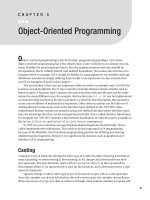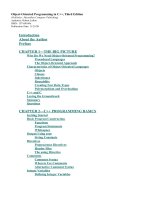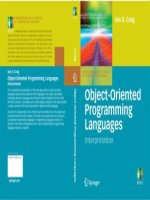Lecture 2: Object Oriented Programming docx
Bạn đang xem bản rút gọn của tài liệu. Xem và tải ngay bản đầy đủ của tài liệu tại đây (169.91 KB, 20 trang )
1
Lecture 2:
Object Oriented Programming
2
Procedural vs. Object-Oriented
Programming
The unit in procedural programming is function, and unit
in object-oriented programming is class
Procedural programming concentrates on creating
functions, while object-oriented programming starts from
isolating the classes, and then look for the methods
inside them.
Procedural programming separates the data of the
program from the operations that manipulate the data,
while object-oriented programming focus on both of them
figure1: procedural figure2: object-oriented
3
Concept of Class and Object
“Class” refers to a blueprint. It defines the
variables and methods the objects support
“Object” is an instance of a class. Each object
has a class which defines its data and behavior
4
Class Members
A class can have three kinds of members:
fields: data variables which determine the status
of the class or an object
methods: executable code of the class built from
statements. It allows us to manipulate/change the
status of an object or access the value of the data
member
nested classes and nested interfaces
5
Sample class
class Pencil {
public String color = “red”;
public int length;
public float diameter;
public static long nextID = 0;
public void setColor (String newColor) {
color = newColor;
}
}
6
Fields – Declaration
Field Declaration
a type name followed by the field name, and
optionally an initialization clause
primitive data type vs. Object reference
boolean, char, byte, short, int, long, float, double
field declarations can be preceded by different
modifiers
access control modifiers
static
final
7
More about field modifiers (1)
Access control modifiers
private: private members are accessible only in the
class itself
package: package members are accessible in
classes in the same package and the class itself
protected: protected members are accessible in
classes in the same package, in subclasses of the
class, and in the class itself
public: public members are accessible anywhere the
class is accessible
8
public class Pencil {
public String color = “red”;
public int length;
public float diameter;
private float price;
public static long nextID = 0;
public void setPrice (float newPrice) {
price = newPrice;
}
}
public class CreatePencil {
public static void main (String args[]){
Pencil p1 = new Pencil();
p1.price = 0.5f;
}
}
Pencil.java
CreatePencil.java
%> javac Pencil.java
%> javac CreatePencil.java
CreatePencil.java:4: price has private access in Pencil
p1.price = 0.5f;
^
9
More about field modifiers (2)
static
only one copy of the static field exists, shared by all
objects of this class
can be accessed directly in the class itself
access from outside the class must be preceded by
the class name as follows
System.out.println(Pencil.nextID);
or via an object belonging to the class
from outside the class, non-static fields must be
accessed through an object reference
10
public class CreatePencil {
public static void main (String args[]){
Pencil p1 = new Pencil();
Pencil.nextID++;
System.out.println(p1.nextID);
//Result?
Pencil p2 = new Pencil();
Pencil.nextID++;
System.out.println(p2.nextID);
//Result?
System.out.println(p1.nextID);
//Result?
}
}
1
still 2!
2
Note: this code is only for the purpose of showing the usage of static
fields. It has POOR design!
11
More about field modifiers (3)
final
once initialized, the value cannot be changed
often be used to define named constants
static final fields must be initialized when the class is
initialized
non-static final fields must be initialized when an object
of the class is constructed
12
Fields –Initialization
Field initialization
not necessary to be constants, as long as with the
right type
If no initialization, then a default initial value is
assigned depending on its type
Type Initial Value
boolean false
char ‘\u0000’
byte, short, int, long 0
float +0.0f
double +0.0
object reference null
13
Methods – Declaration
Method declaration: two parts
1. method header
consists of modifiers (optional), return type, method name,
parameter list and a throws clause (optional)
types of modifiers
•
access control modifiers
•
abstract
the method body is empty. E.g.
abstract void sampleMethod( );
•
static
represent the whole class, no a specific object
can only access static fields and other static methods of the
same class
•
final
cannot be overridden in subclasses
2. method body
14
Methods – Invocation
Method invocations
invoked as operations on objects/classes using the
dot ( . ) operator
reference.method(arguments)
static method:
Outside of the class: “reference” can either be the class
name or an object reference belonging to the class
Inside the class: “reference” can be ommitted
non-static method:
“reference” must be an object reference
15
Method - Overloading
A class can have more than one method with the same
name as long as they have different parameter list.
public class Pencil {
. . .
public void setPrice (float newPrice) {
price = newPrice;
}
public void setPrice (Pencil p) {
price = p.getPrice();
}
}
How does the compiler know which method you’re
invoking? — compares the number and type of the
parameters and uses the matched one
16
Methods – Parameter Values
Parameters are always passed by value.
public void method1 (int a) {
a = 6;
}
public void method2 ( ) {
int b = 3;
method1(b); // now b = ?
// b = 3
}
When the parameter is an object reference, it is the
object reference, not the object itself, getting passed.
Haven’t you said it’s past by value, not reference ?
17
class PassRef{
public static void main(String[] args) {
Pencil plainPencil = new Pencil("PLAIN");
System.out.println("original color: " +
plainPencil.color);
paintRed(plainPencil);
System.out.println("new color: " +
plainPencil.color);
}
public static void paintRed(Pencil p) {
p.color = "RED";
p = null;
}
}
another example: (parameter is an object reference)
plainPencil
plainPencil
plainPencil p
plainPencil p
color: PLAIN
- If you change any field of the object which the parameter refers to, the object is changed
for every variable which holds a reference to this object
color: PLAIN
color: RED
color: RED NULL
p
- You can change which object a parameter refers to inside a method without affecting the
original reference which is passed
- What is passed is the object reference, and it’s passed in the manner of “PASSING BY
VALUE”!
18
The Main Method - Concept
main method
the system locates and runs the main method for a
class when you run a program
other methods get execution when called by the main
method explicitly or implicitly
must be public, static and void
19
The Main Method - Getting Input
from the Command Line
When running a program through the java command, you can
provide a list of strings as the real arguments for the main method.
In the main method, you can use args[index] to fetch the
corresponding argument
class Greetings {
public static void main (String args[]){
String name1 = args[0];
String name2 = args[1];
System.out.println("Hello " + name1 + “&“
+name2);
}
}
java Greetings Jacky Mary
Hello Jacky & Mary
Note: What you get are strings! You have to convert them into other
types when needed.
20
Modifiers of the classes
A class can also has modifiers
public
publicly accessible
without this modifier, a class is only accessible within its own package
abstract
no objects of abstract classes can be created
all of its abstract methods must be implemented by its subclass;
otherwise that subclass must be declared abstract also
final
can not be subclassed
Normally, a file can contain multiple classes, but only one public
one. The file name and the public class name should be the
same









